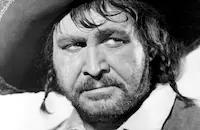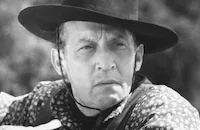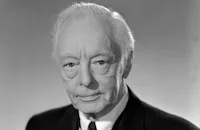Fly Away Baby

Brief Synopsis
Cast & Crew
Frank Mcdonald
Glenda Farrell
Barton Maclane
Gordon Oliver
Hugh O'connell
Marcia Ralston
Film Details
Technical Specs

Synopsis
When jeweler Milton Devereux is killed and a collection of diamonds is stolen, reporter Torchy Blane is assigned to the case. Her fiancé, policeman Steve McBride, is investigating the case, so Torchy tags along as he hunts for the murder weapon. Using her reporter's instinct, Torchy finds the gun hidden in a drainpipe in the alley behind the store. Torchy learns that Devereux had quarreled with Sonny Croy, the son of a rival newspaper owner, over a loan, and that Devereux had threatened to tell Sonny's father that he was living beyond his means. She also learns that during the time Devereux was murdered, Croy was at lunch with Guy Allister, Devereux's partner. Steve and Torchy question the waiter in the restaurant, and she finds a clue on a menu that leads her to believe that Sonny was planning to leave town after the murder. They trace Sonny to the apartment of nightclub dancer Ila Sayre, who insists that Sonny was on the phone with her at precisely the time of the murder. Sonny explains the notes on the menu by saying that he is taking a zeppelin flight around the world as a publicity stunt. Determined to follow Sonny, whom she believes to be the murderer, Torchy talks her paper into sending her around the world in a race against Sonny and another reporter, Hughie Sprague. When the airship lands in Hawaii, Torchy searches Sonny's room and finds a message indicating that some goods will be exchanged in Frankfurt. Sonny discovers her investigation after finding a lipstick that she dropped during the search. Sonny truly seems to be the most likely suspect for the murder after Ila admits that she did not actually talk to Sonny while she was on the phone, but only kept the line open. When Torchy points out that the back door of the restaurant is opposite the back door of the jewelry store, Steve, who has joined Torchy on board the zeppelin, decides to arrest Sonny. This plan is thwarted when they find Sonny dead and discover that the jewels hidden in the false bottom of his suitcase are not diamonds. Torchy puts together various clues to determine that Allister was the actual murderer, and that Sonny was working for him to pay off his debt. They are puzzled, however, because Allister is not on board the airship. After further investigation, they learn that he boarded the ship using a false name. Allister attempts to parachute off the zeppelin, but his parachute does not open properly and he dies. Torchy gets a bonus for her efforts.

Director
Frank Mcdonald
Cast

Glenda Farrell

Barton Maclane

Gordon Oliver

Hugh O'connell
Marcia Ralston

Tom Kennedy
Joseph King

Raymond Hatton
Gordon Hart
Anderson Lawler

Harry Davenport

Emmett Vogan
George Guhl
Crew

Videos
Trailer
Hosted Intro
Film Details
Technical Specs

Articles
Fly Away Baby
The Torchy Blane series placed ace reporter Torchy Blane smack in the middle of a man's world and in every new installment she proved smarter than any male counterpart she can find. The series was produced at a time when great roles for women appeared on the marquee several times a week instead of once or twice a decade, as it seems now. When the series went into production, Glenda Farrell had already made a reputation for herself as a tough talking, no-nonsense character actress in movies such as Mystery of the Wax Museum (1933), where she played the fast talking friend of star Fay Wray. It was no surprise then to anyone that Farrell would play the part.
After the success of the first in the series, Smart Blonde (1937), a second movie, Fly Away Baby was quickly put into production. It gave Torchy the chance to once again show up the police and solve the crime all on her own.
The movie opens with the murder investigation of a banker who's been shot and $250,000 in jewels that have been stolen. Reporters are trying to get inside but police investigator and Torchy's boyfriend, the aforementioned McBride, isn't letting anyone in, especially female reporters. One of his officers, Gahagan (Tom Kennedy), is keeping guard but Torchy fools him and gets inside. Once in, it's revealed that she and McBride are engaged to be married and Torchy wants the license. The problem is there's a murder to solve, too, and Torchy's itching to investigate.
At first she prompts McBride with the proper questions to ask the suspects (questions he can't think of on his own) before getting tired of this and setting out to investigate on her own. She finds the murder weapon before anyone else (so fast McBride half-jokingly asks her if she committed the crime) and soon develops a theory that puts the police to shame.
From there arise a dozen complications and a variety of red herrings until, finally, Torchy finds herself competing in an around the world race just to catch the killer (don't ask, it's a Torchy Blane movie). Telling any more of the plot would spoil too much of the fun and if the Torchy Blane movies are anything, they're fun. Directed with a briskness by Frank McDonald, a contract director for Warner Brothers, Fly Away Baby, like the other movies in the series, is a no frills mystery, produced for the purpose of entertainment, not high art. It's not about the great cinematography or editing or music, it's about watching the wonderful Miss Farrell show up the police and the bad guys while charming both.
It took a while for the studios to figure out what to do with Farrell. She started out doing small roles in drama, including the part of Paul Muni's devoted girlfriend in the social drama masterpiece, I Am a Fugitive from a Chain Gang (1932) and the object of Edward G. Robinson's eye in Little Caesar (1931). Then came The Mystery of the Wax Museum and her fast talking charms were finally apparent. Farrell would play the same type of character, in one variation after another, for most of the rest of her career.
Torchy Blane became Farrell's greatest character and she ended up playing the role seven times out of nine movies. They replaced her with Lola Lane for the fifth movie but brought Farrell back for the sixth, seventh and eighth. When she backed out after that, Jane Wyman got the role for one more movie but without Farrell, it didn't prove a success. It's nothing against Lane or Wyman, terrific actresses both. It's just that when it comes to Torchy, there's only one and her name is Glenda.
By Greg Ferrara

Fly Away Baby
Quotes
Trivia
The famous Broadway columnist, "What's My Line?" (1950) star and possible murder victim Dorothy Kilgallen contributed to the script of this film. It is (very) loosely based on her participation in an around the world air race, as chronicled in Lee Israel's excellent book, "Kilgallen."
Notes
According to contemporary sources, Dorothy Kilgallen's idea was based on her own participation in a race around the world by air with two male reporters. For additional information on the "Torchy Blane" series, consult the Series Index and for Smart Blonde.

















